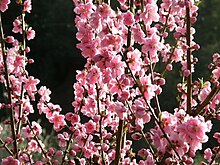Princess Tomohito of Mikasa
Whilst in the UK she met her future husband, Prince Tomohito of Mikasa, himself a student at Oxford University.
As tradition dictates, upon her entry into the imperial family and like other members, she received a personal emblem (o-shirushi (お印)): the flower of prunus persica (hanamomo (花桃)).
The couple had two daughters: The family lived in a compound within the Akasaka Estate complex, in Moto-Akasaka, Minato, Tokyo.
[1] The Princess accompanied her husband on various missions abroad to charity and welfare events, especially those concerning health issues.
[3] In July 1994, Nobuko visited Australia on her own to support the Sydney Royal Research Institute for those with audio-visual disabilities.
[3] In April 1998, Tomohito and Nobuko travelled to Turkey to attend the opening ceremony of the Turkey-Japan Foundation Cultural Centre.
[3] On 1 November 2013, Princess Tomohito of Mikasa visited Fukushima Prefecture and met with the people affected by the earthquake which occurred on 11 March 2011.
Princess Nobuko suffered from brain ischemia in May 2004, which forced her to withdraw for a while to the villa of Sōma family in Karuizawa, Nagano Prefecture, for medical treatment and rest.
The next morning, due to persistent pain, the Princess went to Keio University Hospital in Tokyo, where she was diagnosed with a first lumbar vertebral fracture.
[16][17] The Princess was discharged from the hospital on 24 November, after doctors confirmed that her recovery was going well and that the chances of cancer recurrence were very low.
[24] Through her link to the Ōkubo clan, she is an eighth cousin of her late husband and of the present Emperor; all three are seven-times-great-grandchildren of the sixth lord of Hirado, Matsura Atsunobu (1684–1757).
[25] They are also tenth cousins by virtue of their descent from Seikanji Hirofusa (1633–1686), a senior palace courtier who held the rank of dainagon in the late-17th century.

